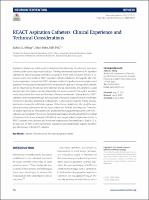| dc.contributor | Vall d'Hebron Barcelona Hospital Campus |
| dc.contributor.author | Ribó Jacobi, Marc |
| dc.contributor.author | Li, Jiahui |
| dc.date.accessioned | 2022-09-12T09:18:29Z |
| dc.date.available | 2022-09-12T09:18:29Z |
| dc.date.issued | 2022-07 |
| dc.identifier.citation | Li J, Ribo M. REACT Aspiration Catheters: Clinical Experience and Technical Considerations. Neurointervention. 2022 Jul;17(2):70–7. |
| dc.identifier.issn | 2093-9043 |
| dc.identifier.uri | https://hdl.handle.net/11351/8146 |
| dc.description | Catheter; Mechanical aspiration; Stroke |
| dc.description.abstract | Aspiration catheters are widely used in mechanical thrombectomy procedures to treat acute ischemic stroke due to large vessel occlusion. The key performance requirements for aspiration catheters are ease of navigation and effective aspiration. In this work, we review the clinical experience and in vitro studies of REACT aspiration catheters (Medtronic, Minneapolis, MN, USA). In vitro experiments showed that REACT catheters exhibit solid performance in navigation and aspiration. Previous studies reported that the recanalization capacity of the aspiration catheters can be influenced by the devices’ inner diameter and tip distensibility, the catheter-to-vessel diameter ratio, the negative pressure delivered by the vacuum generator, the cyclical aspiration mode, the proximal flow arrest, and the angle of interaction between catheter and clot. REACT catheters can be navigated through the vasculature without any support from a microcatheter/ microwire in favorable anatomical configurations. In challenging situations, mostly encountered when crossing the ophthalmic segment of the internal carotid artery, the use of the stentriever anchoring technique or delivery assist catheter can facilitate the navigation. Three clinical studies reporting on 299 patients who underwent mechanical thrombectomy with REACT catheters were included in this review. Successful recanalization (modified treatment in cerebral ischemia score 2b–3) was achieved in 89–96% of cases, no procedural complications related to REACT catheters were reported, and functional independence (modified Rankin Scale 0–2) at 90-days was 24–36%. In vitro experimental evaluations and clinical studies support the safety and effectiveness of the REACT catheters. |
| dc.language.iso | eng |
| dc.publisher | Korean Society of Interventional Neuroradiology |
| dc.relation.ispartofseries | Neurointervention;17(2) |
| dc.rights | Attribution-NonCommercial 4.0 International |
| dc.rights.uri | http://creativecommons.org/licenses/by-nc/4.0/ |
| dc.source | Scientia |
| dc.subject | Malalties cerebrovasculars - Cirurgia |
| dc.subject | Vasos sanguinis - Cirurgia |
| dc.subject | Cateterisme arterial |
| dc.subject.mesh | Stroke |
| dc.subject.mesh | /surgery |
| dc.subject.mesh | Thrombectomy |
| dc.subject.mesh | Catheters |
| dc.title | REACT Aspiration Catheters: Clinical Experience and Technical Considerations |
| dc.type | info:eu-repo/semantics/article |
| dc.identifier.doi | 10.5469/neuroint.2022.00255 |
| dc.subject.decs | accidente cerebrovascular |
| dc.subject.decs | /cirugía |
| dc.subject.decs | trombectomía |
| dc.subject.decs | catéteres |
| dc.relation.publishversion | https://doi.org/10.5469/neuroint.2022.00255 |
| dc.type.version | info:eu-repo/semantics/publishedVersion |
| dc.audience | Professionals |
| dc.contributor.organismes | Institut Català de la Salut |
| dc.contributor.authoraffiliation | Unitat d’Ictus, Servei de Neurologia, Vall d’Hebron Hospital Universitari, Barcelona, Spain. Departament de Medicina, Universitat Autònoma de Barcelona, Bellaterra, Spain |
| dc.identifier.pmid | 35718472 |
| dc.rights.accessrights | info:eu-repo/semantics/openAccess |

